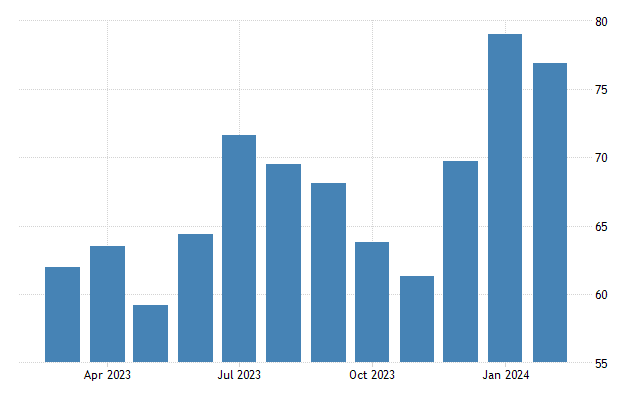What to expect from US Industrial Production data
Scheduled for release at 14:15 GMT on Friday, March 15, the US Industrial Production data for February is highly anticipated by economists, policymakers, and investors. This report provides crucial insights into the performance and trends within the manufacturing, mining, and utility sectors, offering valuable indications of economic activity and potential shifts in industrial output.
In the previous month, industrial production (MoM) experienced a marginal decline of 0.1 percent in January, following a period of no change in December. In February there is expected to be no change to January’s reading. This modest contraction underscores the need for close attention to the upcoming data release to assess whether this trend persists or if there are signs of recovery in industrial output.
One key metric to watch closely is Capacity Utilisation, which measures the extent to which industries are operating at full capacity. For February, economists expect a utilisation rate of 78.5 percent, mirroring the previous month’s figure. However, it’s worth noting that capacity utilisation declined by 0.2 percent from December 2023, indicating potential constraints on production capacity.
Given the importance of the industrial sector in driving overall economic growth, any deviations from expectations in the upcoming data could have significant implications for market sentiment and policy decisions. A stronger-than-expected industrial production figure may fuel optimism about economic expansion and bolster investor confidence, potentially leading to positive movements in financial markets. Conversely, if industrial production stagnates or experiences further contraction, it could raise concerns about the resilience of the economy and the effectiveness of current policy measures. This scenario might prompt policymakers to consider additional stimulus or intervention to support industrial activity and overall economic recovery.
What to expect from the Michigan Consumer Sentiment Index
The Michigan Consumer Sentiment Index, scheduled for release at 15:00 GMT on Friday, March 15, is a crucial gauge of consumer confidence and sentiment in the United States. Compiled by the University of Michigan, this index reflects consumers’ perceptions of current economic conditions and their expectations for future economic prospects.
Economists are closely watching the March edition of the Michigan Consumer Sentiment Index, with expectations set at 76.9, unchanged from the previous month’s reading. This index serves as a barometer for consumer sentiment, providing valuable insights into consumer behaviour, spending patterns, and overall economic vitality. Another key component of the Michigan Consumer Sentiment Index is the UoM 5-year Consumer Inflation Expectation, which measures consumers’ expectations for future inflation over a five-year horizon. In the previous month, this indicator stood at 2.9%, so it will be crucial to see where this comes in.

A higher-than-expected reading in the Michigan Consumer Sentiment Index could signal increased consumer optimism, suggesting potential strength in consumer spending and economic growth. Conversely, a lower-than-anticipated reading may indicate waning confidence among consumers, raising concerns about the resilience of the economy. Market reactions to the Michigan Consumer Sentiment Index release are often swift and significant, as investors adjust their expectations and positions based on the perceived health of consumer sentiment. Positive sentiment may buoy stock markets and other risk assets, while negative sentiment could lead to increased volatility and risk aversion.
Understanding US Industrial Production Data
Industrial production data measures the total output of the manufacturing, mining, and utilities sectors in the United States. It provides a comprehensive overview of the country’s industrial activity and is a key indicator of economic health. The Federal Reserve releases this data monthly, making it an essential tool for policymakers, investors, and economists alike.

Industrial production is crucial because it reflects the level of utilisation of industrial capacity, indicating the economy’s productive capacity and potential for growth. An increase in industrial production suggests higher levels of economic activity, job creation, and consumer spending. Conversely, a decline may signal economic contraction, reduced business investment, and potential job losses.
Several factors influence industrial production, including consumer demand, business investment, global trade dynamics, and government policies. For example, increased consumer spending can drive demand for manufactured goods, leading to higher industrial production. Conversely, trade tensions or changes in regulatory policies can disrupt supply chains and negatively impact industrial output.
Moreover, industrial production data provides insights into specific sectors of the economy, such as manufacturing, which plays a significant role in overall economic performance. Manufacturing output reflects the production of goods ranging from automobiles and machinery to electronics and appliances, serving as a gauge of economic competitiveness and innovation.
Given its importance, industrial production data is closely monitored by investors seeking clues about future economic growth and inflation trends. Central banks, such as the Federal Reserve, use this data to assess the state of the economy and make decisions regarding monetary policy, including interest rate adjustments.
Understanding the Michigan Consumer Sentiment Index
The Michigan Consumer Sentiment Index (MCSI) is a crucial economic indicator that measures the confidence and outlook of consumers in the United States regarding their financial situation and the overall economy. Compiled by the University of Michigan, this index provides valuable insights into consumer sentiment, spending patterns, and economic expectations.
The MCSI is derived from a monthly survey of a representative sample of American households, capturing their perceptions of current economic conditions and their expectations for the future. It is composed of two main components: the Current Economic Conditions Index and the Consumer Expectations Index.
Current Economic Conditions Index: This component of the MCSI reflects consumers’ assessments of their present financial situation and the overall state of the economy. It takes into account factors such as employment levels, income stability, and inflationary pressures.
Consumer Expectations Index: This index measures consumers’ outlook for the future, including their expectations regarding employment prospects, income growth, and general economic conditions. It provides insights into consumer confidence levels and their willingness to make significant purchases or investments in the coming months.
The Michigan Consumer Sentiment Index is closely monitored by economists, policymakers, and investors as it serves as a leading indicator of consumer behaviour and economic activity. High levels of consumer confidence typically coincide with increased consumer spending, which drives economic growth. Conversely, a decline in consumer sentiment may signal potential economic challenges, such as reduced spending and weakened business activity.
Given its influence on consumer spending, which accounts for a significant portion of overall economic activity, the MCSI plays a crucial role in shaping monetary policy decisions, business strategies, and financial market movements. Therefore, analysts carefully scrutinize the index’s fluctuations to gauge the health and direction of the U.S. economy.